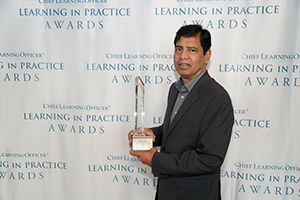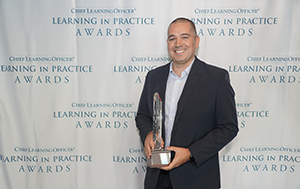The Strategy Award is for learning executives who have demonstrated exceptional business acumen combined with forward-looking vision to develop and execute a comprehensive learning strategy that clearly aligns employee development with broader organizational strategy.
DIVISION 1: For companies with 10,000 employees or more
GOLD
Damodar Padhi, Vice president and Global Head of Talent Development, Tata Consultancy Services
Technology and its network effect are changing industries worldwide. That’s something learning and development expert Damodar Padhi has to cope with daily. Our rapidly changing technological environment has resulted in the redesign of Tata Consultancy Services’ business model.

TCS used to educate its workers in classrooms, but that wasn’t enough to keep up with the digitally competent world. Something had to change. To help his 390,000-plus employees become more familiar with new technology, Padhi created a digital learning course called “The Continuous Learning Program.” CLP provides lessons on technologies, domains, leadership, behavior, culture and language. One of its main perks is that employees can use it anytime, anywhere. Therefore, employees can gradually learn and grow their skills.
Through CLP, Padhi successfully completed his goal. He found a way to have an easily accessible program that can teach his employees additional technology skills. The program has many effective features. It includes online courses, videos, gamification and simulations that can be seen on personal devices such as smartphones and iPads. The tools for learning and development are there, and it has generated a positive buzz for TCS.
Employees have gained more than three million competencies across proficiency levels with the help of this program. In addition, more than 350,000 employees have had access to nearly 14,000 learning programs. Customers have started to notice employees becoming more adaptive to technology as well. The customer satisfaction index has increased from 90 to 92 percent in the past three years.
SILVER
Laurie Jeppesen, Global Assurance Learning and Education Leader, PwC
As digital disruption in business is becoming a trend, changes must be made to adapt. Business and people models are rapidly changing. To address this matter, PwC’s Laurie Jeppesen changed her company’s audit training curriculum. The curriculum traditionally involved four programs, each lasting one to two weeks. In Jeppesen’s new initiative, she created 109 training events that could be run separately or together. PwC worked with their key stakeholder group — the Assurance L&E Network — to perform the following: list every topic, replace training overlap and substitute long courses with a flexible solution. This plan was in the works for three years without a budget. With the help of three tools — an interactive Excel feature, a website to access materials and a standardized curriculum for small firms — Jeppesen’s program came to fruition. The curriculum received exceptional firm and participant ratings. In addition, there was an average of only 2.7 attempts to pass the courses. This solidifies PwC’s reputation as a top-tier professional services brand.
BRONZE
Alanna Corrigan, Senior Director, Corporate Customer Service Training, Air Canada
At Air Canada, there was one lingering issue: Employees had to leave work for a full-day class to complete training. That became problematic, as employee routine and productivity declined. Alanna Corrigan’s corporate training team introduced the Airports Digital Learning initiative so employees could complete training during work hours. This technological training method has its perks. Made in large part to combat the stressors of working in an airport environment, café-style learning stations were developed within airport locations. These stations include comfortable seating, coffee and touchscreens. The initiative has resulted in cost savings and overall satisfaction from Air Canada’s 23,000-plus employees.
DIVISION 2: For companies with less than 10,000 employees
GOLD
Scott Hammond, Senior Manager, Industry Programs, Autodesk

Autodesk’s recent business model change led to an expansion of its Architecture, Engineering and Constructing market. This not only targeted enagement with new companies, but also new roles within those companies. Autodesk’s employees now had to engage an unfamiliar group — company executives. But how? At Autodesk, making good conversation with potential customers is vital to making a sale. Knowing this, Scott Hammond implemented ways to help his salesforce improve their conversation strategies with clients. Hammond’s team identified three challenges in doing this: helping sales and partners engage new customers, creating and delivering appealing content, and helping those involved retain knowledge. To address the first challenge, Hammond created an AEC customer conversation guide. The guide provided sales with resources including customer profiles, buyer challenges and how to conduct an executive conversation. With regard to the second challenge, the team created “insight videos.” These videos are short, mobile and fun pieces of learning content that Hammond’s team could absorb in just 90 seconds. For the third challenge, Hammond took into consideration that his sales team loves competition. So he created a platform that sends out two to three trivia questions per day through a mobile app. After answering the questions, employees explained why their answer was correct or incorrect. Through these three actions, change was made for the better. Partners who took advantage of Hammond’s program had 30 percent more sales opportunities than those who didn’t take the program. To make things better, the trivia platform rose sales’ retention of knowledge from 60 to 80 percent.
SILVER
Kathleen McCutcheon, Vice President, Human Resources, Tokio Marine HCC
Despite its fast growth, Tokio Marine HCC lacked something very important: leadership development programs. As acquisitions grew, more employees proved less than ideal in terms of leadership. Kathleen McCutcheon came to the rescue. McCutcheon worked with her senior leadership team to create a leadership development function. It required numerous conversations and brainstorming sessions with executives.
The talent development team labeled Tokio Marine HCC in terms of roles and responsibilities. From there, four programs were created. The first program, Foundations of Leadership, was made for newly promoted and newly hired. Next was a program targeting evolving leaders called LEaD, or Leadership Excellence and Development. The third program focused on leaders of business units. Last, the fourth program created development opportunities for senior executives of the organization. These programs are already looking to be a huge success. Findings aren’t fully determined yet, as it will take several years to configure. However, based on early results, 20 percent of participants have received promotions.
BRONZE
Lisa Druet, Senior Manager, E. & J. Gallo Winery
In any business, it is imperative that employees are skilled and motivated. To meet this need, Lisa Druet created an advanced manufacturing training center to educate new employees. Her idea was divided into phases including design, construction and benchmarking. The hard work paid off. The center, which is more than 12,000 square feet, consists of three classrooms, a computer lab, a quality lab, multipurpose rooms and a large production simulation environment. Thanks to Druet’s efforts, it is estimated that the training center will reduce time to competency by at least 25 percent and deliver more effective training.














